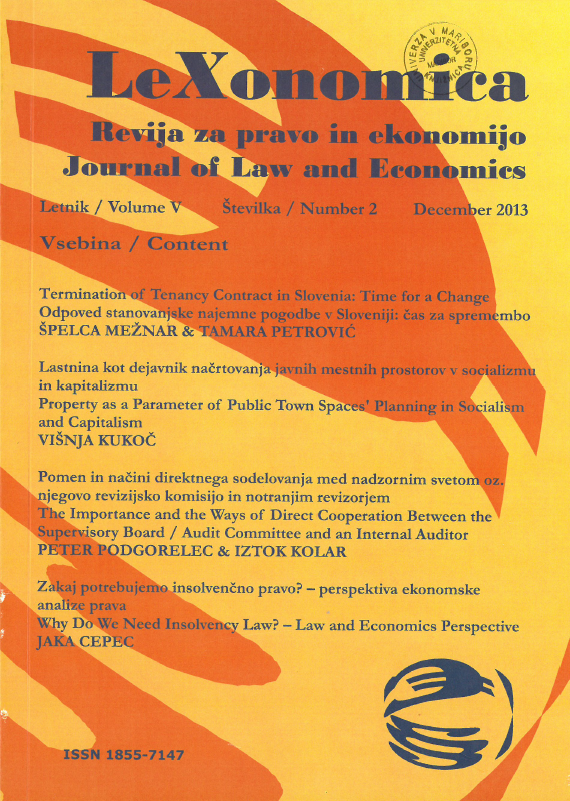Neizkrivljena konkurenca na račun omejitve izvrševanja pravic intelektualne lastnine – pregled sodne prakse Sodišča EU
Keywords:
intellectual property rights, abuse of a dominant position, exclusivity of rights, undertaking, entry barriers, distorting competitionAbstract
Prispevek obravnava pristop Sodišča EU k omejevanju pravic intelektualne lastnine, kadar njihovo izvrševanje predstavlja zlorabo prevladujočega položaja, ki je prepovedana po členu 102 Pogodbe o delovanju Evropske unije. Imetništvo pravice intelektualne lastnine samo po sebi sicer ne pomeni prevladujočega položaja, nedvomno pa povečuje možnosti zanj, saj so te pravice ekskluzivne in tako poleg ekonomske prednosti dajejo imetniku možnost, da druga podjetja na trgu izključi od izvrševanja te pravice oz. jim celo oteži ali prepreči vstop na trg. Skozi sodno prakso bomo predstavili, kako Sodišče EU vedno bolj posega v izvrševanje pravic intelektualne lastnine, da bi preprečilo imetniku prevladujočega položaja izkrivljati konkurenco, ter razložili, zakaj lahko takšen pristop podjetja na trgu odvrne od vlaganja v razvoj in inovacije ter na dolgi rok zavira konkurenco.
This paper addresses the approach of the Court of Justice of the European Union ('CJEU') to limiting intellectual property rights when the exercise of such rights constitutes a breach of Article 102 of the Treaty on the Functioning of the European Union, which prohibits abuse of a dominant position. While holding the intellectual property right ('IP right') in itself does not per se amount to holding a dominant position, the existence of the latter is undoubtedly enforced by the exclusive nature of the former, since the exclusivity provides the holder of such right not only with the economic advantage towards other undertakings on the market, but also with the possibility to constitute entry barriers for undertakings trying to enter the market. Through the review of the case law of the CJEU, this paper presents how the Court is continuously restricting the exercise of the IP rights with the aim of terminating, or even preventing, the dominant undertaking's abuse of its position and, accordingly, distortion of competition. Based on the findings, it is attempted to explain why such approach can deter subjects on the market from further research and development and moreover, reduce competition in the long-term aspect.
Downloads
References
Bently, L., Sherman, B. (2011) Intellectual Property Law, Third Edition (Oxford: Oxford University Press).
Cole, M. (2013) Pharmaceuticals and Competition: First strike to the Commission? 34(5) ECLR.
Etro, F., Kokkoris, I. (2010): Competition Law and the Enforcement of Article 102 (Oxford: Oxford University Press).
Fairhurst, J. (2010) Law of the European Union, Seventh Edition (Essex: Pearson Education Limited).
Hoehn, T., Lewis, A. (2013) Interoperability Remedies, FRAND Licensing and Innovation: A Review of Recent Case Law, 34(2) ECLR.
Jones, A., Sufrin, B. (2011) EU Competition Law, Texts, Cases, and Materials, Fourth Edition(Oxford: Oxford University Press).
Repas, M. (2002) Dodatni varstveni certifikat – daljše monopolno varstvo za farmacevtske proizvode, Podjetje in delo 8/2002.
Repas, M.(2010) Konkurenčno pravo v teoriji in praksi: omejevalna ravnanja in nadzor koncentracij, (Ljubljana, Uradni list RS).
Rousseva, E. (2010) Rethinking Exclusionary Abuses in EU Competition Law (Oregon/Portland: Hart Publishing Ltd).
Stothers, C. (2012) When is Copyright Exhausted by a Software Licence? UsedSoft v Oracle, EIPR, Issue 12.
Tritton, G. et al. (2008) Intellectual Property in Europe, Third Edition (London: Sweet&Maxwell).
Whish, R. (2009) Competition Law, Sixth Edition (Oxford: Oxford University Press).
Downloads
Published
Issue
Section
License
© Univerza v Mariboru, Pravna fakulteta, Univerzitetna založba
Prosti pristop
